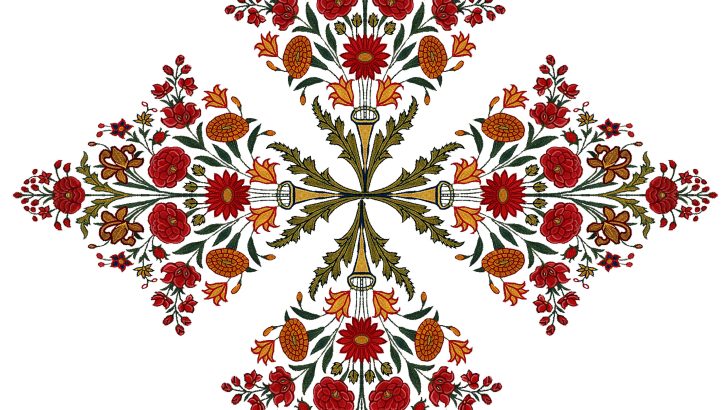Floral and faunal embroidery motifs have long been a staple in the world of textile art, offering a blend of natural beauty and cultural significance that continues to captivate modern sewers. These intricate designs, often inspired by the flora and fauna of various regions, bring a sense of history and craftsmanship to contemporary sewing projects. Whether you’re an experienced embroiderer or just starting out, incorporating floral and faunal motifs can elevate your work with timeless elegance. The enduring appeal of these motifs lies in their ability to connect us with nature while providing a versatile canvas for creative expression. As more individuals seek unique, handcrafted items, the demand for such traditional yet adaptable designs has seen a resurgence in recent years. This article explores the rich heritage of floral and faunal embroidery, the techniques involved in creating these motifs, and how they can be seamlessly integrated into modern sewing projects.
The Historical Significance of Floral and Faunal Embroidery
Embroidery has been a part of human culture for thousands of years, with early examples found in ancient civilizations such as Egypt, China, and the Middle East. Floral motifs, in particular, have been used to symbolize themes like love, fertility, and renewal. In many cultures, specific flowers held deep symbolic meanings—roses for love, lotus for purity, and peonies for prosperity. Similarly, faunal embroidery often depicted animals that were considered sacred or significant within a community. For example, in medieval Europe, lions and eagles were common symbols of power and authority, while in Asian traditions, dragons and phoenixes represented strength and transformation. These motifs were not only decorative but also served as storytelling tools, conveying messages about identity, beliefs, and social status. Over time, these designs evolved, influenced by trade, migration, and changing artistic trends, yet their core essence remained intact. Today, the legacy of these historical motifs lives on, inspiring modern artisans to reinterpret them in fresh and innovative ways.
Techniques for Creating Floral and Faunal Embroidery
The process of creating floral and faunal embroidery involves a combination of skill, patience, and creativity. One of the most popular techniques is counted thread embroidery, where stitches are made based on a grid pattern, ensuring precision and symmetry. This method is particularly effective for intricate floral designs, allowing for detailed patterns that mimic real-life botanical elements. Another common technique is freehand embroidery, which offers greater flexibility and allows for more organic shapes, making it ideal for depicting animals and other faunal subjects. When working with faunal motifs, attention to detail is crucial—each feather, scale, or fur strand must be carefully rendered to capture the essence of the animal. Additionally, the choice of thread color and texture plays a vital role in bringing the design to life. For instance, using metallic threads can add a touch of luxury to a floral motif, while variegated threads can create a realistic effect in faunal embroidery. Whether you’re using traditional methods or modern tools like digital embroidery machines, mastering these techniques requires practice and a deep understanding of the materials at hand.
Incorporating Floral and Faunal Motifs into Modern Sewing Projects
In today’s fast-paced world, there is a growing appreciation for handmade and personalized items, making floral and faunal embroidery a valuable addition to modern sewing projects. These motifs can be applied to a wide range of items, from clothing and accessories to home decor and quilts. For example, adding a delicate floral pattern to a dress or a handbag can give it a unique, artisanal feel, while a faunal design on a quilt can serve as a focal point that tells a story. Moreover, these motifs can be adapted to suit different styles—whether you prefer a minimalist approach with subtle details or a bold, vibrant composition. Many sewers also enjoy combining multiple motifs in a single project, creating a cohesive and visually appealing design. Additionally, the use of modern materials such as synthetic threads and laser-cut fabric templates has made it easier than ever to experiment with these traditional designs. By blending old-world charm with contemporary techniques, sewers can create one-of-a-kind pieces that reflect both personal style and cultural heritage.
Tips for Choosing and Customizing Embroidery Motifs
When selecting floral and faunal embroidery motifs, it’s important to consider the purpose of the project and the desired aesthetic. For instance, if you’re creating a piece for a special occasion, such as a wedding or a baby shower, choosing motifs that carry symbolic meaning can add a deeper layer of significance. On the other hand, if you’re looking for something more casual, opting for simple, repetitive patterns may be more appropriate. Another factor to consider is the size and complexity of the motif—larger, more detailed designs may require more time and skill, while smaller, simpler ones can be completed quickly. Customization is another key aspect of embroidery, allowing you to tailor motifs to fit your specific needs. This can involve adjusting the scale, altering the color palette, or even combining different elements to create a unique design. Many online resources and embroidery software programs offer tools for modifying existing motifs, making it easier to personalize your work. Ultimately, the goal is to find a balance between tradition and innovation, ensuring that your embroidered creations are both meaningful and visually striking.
